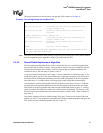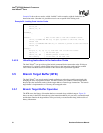
Hardware Reference Manual 89
Intel
®
IXP2800 Network Processor
Intel XScale
®
Core
The instruction cache is virtually addressed and virtually tagged. The virtual address presented to
the instruction cache may be remapped by the PID register.
3.4.1 Instruction Cache Operation
3.4.1.1 Operation when Instruction Cache is Enabled
When the cache is enabled, it compares every instruction request address to the addresses of
instructions that it is holding in cache. If the requested instruction is found, the access “hits” the
cache, which returns the requested instruction. If the instruction is not found, the access “misses”
the cache, which requests a fetch from external memory of the 8-word line (32 bytes) that contains
the instruction (using the fetch policy). As the fetch returns instructions to the cache, they are put in
one of two fetch buffers and the requested instruction is delivered to the instruction decoder. A
fetched line is written into the cache if it is cacheable (code is cacheable if the MMU is disabled or
if the MMU is enabled and the cacheable (C) bit is set to 1 in its corresponding page).
Note: An instruction fetch may “miss” the cache but “hit” one of the fetch buffers. If this happens, the
requested instruction is delivered to the instruction decoder in the same manner as a cache “hit.”
Figure 18. Instruction Cache Organization
A9685-01
8 Words (cache line)
DataCAM
Tag
Instruction Address (Virtual)
Note: CAM = Content Addressable Memory
Set Index
Word Select
Instruction Word
(4 bytes)
Word
way 0
Set 31
Set 1
way 1
31 54 21010 9
8 Words (cache line)
DataCAM
way 0
way 1
Set 0
8 Words (cache line)
DataCAM
way 0
way 1
way 31
Tag
This example
shows Set 0 being
selected by the
Set Index
Set Index


















